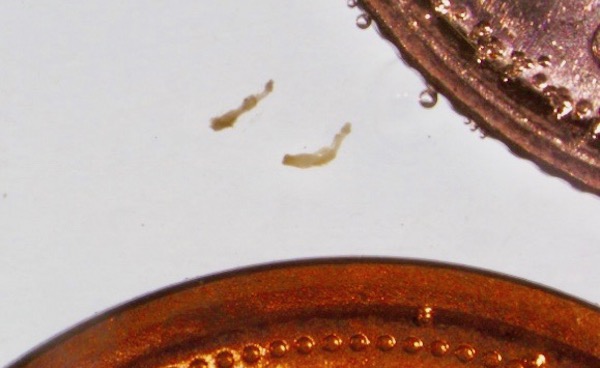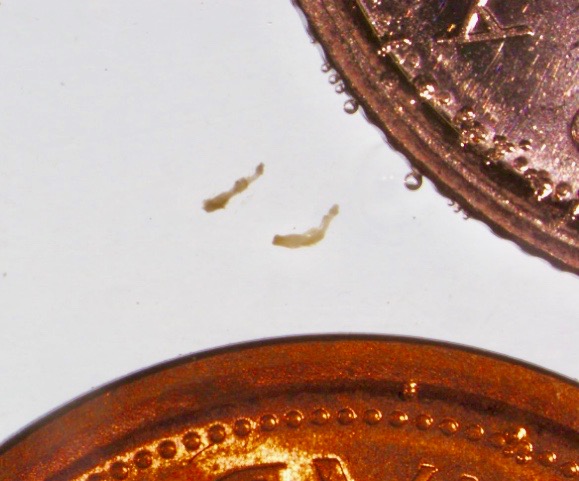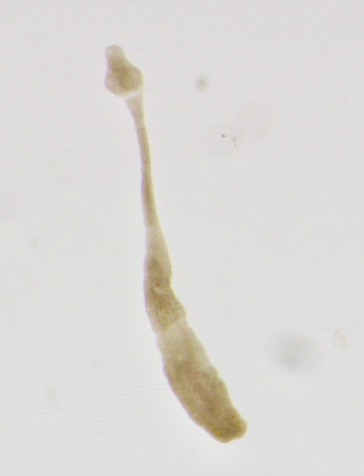Mila Bassil, New Science Communicator
Harsh terrain and brutally cold temperatures are not the only dilemmas Arctic dwellers face. Dr. Emily Jenkins and her team of researchers at the University of Saskatchewan’s Western College of Veterinary Medicine have identified parasites in the gastrointestinal tract of carnivores from northern Canada as Echinococcus spp, a small tapeworm no larger than a mustard seed. Despite its miniscule size, Echinococcusis extremely dangerous.
Echinococcus multilocularis and E. canadensis are two species of the parasite that are present and emerging in Canada. Although the parasite occurs worldwide and many cases of human echinococcosis have been diagnosed elsewhere, few Canadians are aware of the growing risk. The World Health Organization considers human echinococcosis to be a “neglected tropical disease,” but Echinococcus is not restricted to the tropics – and it appears to be becoming more common, even in regions as cold as the Canadian North.
In the Arctic, E. canadensis often uses wolves as definitive hosts – hosts that are required for the parasite to survive or reproduce – but can infect coyotes, foxes and other members of the dog family, including pets. Moose, elk, deer and other cervids usually serve as intermediate hosts in which the parasite undergoes development and asexual reproduction. E. multilocularis also uses dogs as definitive hosts, but typically circulates in rodent intermediate hosts.
Echinococcusis a public health concern because it also infects people. Echinococcosis, a condition where a large cyst develops in the liver, lungs or other organs, can develop when people consume Echinococcus eggs shed by definitive hosts, often pet dogs that have scavenged on wildlife carcasses. Dogs, as both intermediate and definitive hosts of the parasite, are also at risk of developing echinococcosis.
“The cysts can affect people in the same way that a tumour would,” says Joy Wu, an undergraduate research student working in the Jenkins lab. “Just like cancer, echinococcosis can be a very serious illness that may require surgical or chemotherapeutic treatment.”
Of particular concern is that, when infected, intermediate hosts show no clinical signs. This means owners of infected dogs may have no idea their pets are carrying the parasite in their gastrointestinal tracts. This puts humans at high risk of being infected unknowingly.
At the Jenkins lab, adult Echinococcus worms were collected and counted from the intestines of wolverines, coyotes, wolves, red foxes and arctic foxes that had been trapped or hunted in the Yukon and Northwest Territories for other purposes. Researchers then confirmed that the worms were either E. canadensis or E. multilocularis using a technique known as polymerase chain reaction, or PCR.
With PCR, researchers extract DNA from the worms, amplify it, and then analyze it to determine which exact species the worm is. This allows researchers to know what species the worm is without having to rely only on morphology, which can be very unreliable since both worms look very similar.

Jars with segments of Arctic fox intestine submerged in water. The contents of the jars are about to be filtered and examined under a microscope so that the number of Echinococcus spp adults can be counted. This technique is considered the gold standard for determining the intensity of Echinococcus spp infection in an animal’s gastrointestinal tract. Photo: Mila Bassil
The researchers found that E. canadensis was highly prevalent (76%) among wolves in the Yukon, while E. multilocularis was highly prevalent (26%) in Arctic foxes from islands off Inuvik in the Northwest Territories. By determining how common these parasites are, researchers are trying to gauge whether people living in the Canada’s north face increased risk for infection.
“If we see that the parasite is present in more wildlife than it has been in the past, then we can predict that it is more likely for humans to come into contact with it since it is more abundant in the population overall,” Wu says. “If more wild animals are infected, the parasite can spread between more animals more quickly, and domestic animals and people who come into contact with wildlife will be at a much higher risk of becoming infected.”
Rajnish Sharma, a graduate student working in the Jenkins lab, says that “based on a qualitative risk assessment, E. multilocularis has been ranked as the most important zoonotic parasite in the North from a public health point of view.” He says Echinococcus “has been an emerging parasite in the Canadian North due to multiple factors, including climate change and people-wildlife interfaces.”
Climate change and increasing interactions between people and wildlife may also be allowing Echinococcus – and possibly other parasites – to increase in the rest of Canada.

Dogs can be both intermediate and definitive hosts for Echinococcus spp. Contact with infected dogs is the most common way human develop echinococcosis. Regular de-worming treatments can help protect you and your dog from infection. Photo: Mila Bassil
Echinococcus eggs are extremely resilient to cold temperatures. For example, researchers had to freeze samples at –80º C to inactivate any eggs before they could safely analyze them. Even with the extreme cold tolerance of Echinococcus, Sharma predicts that the parasite will become even more abundant in the Arctic if temperatures were to increase. Rising temperatures and longer summers in the Arctic will extend the breeding season and allow more wildlife to survive in these regions. More wild animals means not only more hosts available for Echinococcus and other parasites to infect, but more sources of infection for animals and people altogether.
Few Canadians are aware of the risk that is emerging in our backyards. Echinococcus, a dangerous parasite known to be the cause of a widespread disease in the tropics, appears to be spreading and becoming more common in Canada – including in northern regions. As climate change continues to progress and the breeding and migration patterns of northern wildlife shift in response, we may – to our regret – find ourselves becoming far too familiar with this tiny tapeworm.
~30~
Join us every Monday this month to read works by our other Pitch and Polish graduates:
January 7, 2019: Veterinary researchers seek clues to more effective treatment for deadly dog disease, by Nolan Chalifoux
January 14, 2019: Llama drama: Research into the mechanics of llama ovulation reveals a rare tumour, by Kylie Hutt
January 28, 2019: Ramp walking helps diagnose lameness in dogs, by Emma Thomson
February 4, 2019: Multidisciplinary collaboration helps researchers solve complex, real-world problems







I myself have been very sick w parasites. Every doc says I need mental help or I’m on drugs. I came your article when I used my Google Lens to see what parasite was in my poop. To me they look like flukes. Occasional rope worm. I’m not sure. I’m going to a holistic doctor that told me I do have parasites. She did give me some medicine that seems to be somewhat working. I am willing to be your guinea pig if you need help on anything. I am sick of being sick. I honestly can’t think straight half the time.
What you should do with those doctors is bring a stool sample in a ziplock for them 😀
I probably would..heh
My daughter has them very bad what can I do to help her .Docs are insane also not to believe them
Amber,
I am so sorry that you are going through all of this and have been for so long. I’m right behind you with about 7 months of knowing that I was infected with what still seems like quite a variety of these damn creatures that have taken over my body inside and now outside also. I feel your frustration with the doctors and emergency room visits and the everyone thinking that you are nuts. I keep everything that comes out of me (except the poop) in ziplock bags and containers and take pictures of everything that comes out. I just wanted you to know that you are not alone in this. . Reading your story really hit home and for once I felt not alone in this battle. I would love to chat more with you or anyone on here that is struggling with this. We need each other to not only see what people have learned or gone through but to support each other through these times. I will post a more detailed history soon and maybe someone will get something out of it.
Hang in there and yes… easier said than done. Also, thank you being vulnerable and clearly honest with sharing your
story. You helped me get through another day.
Mindy
I know exactly what you’re talking about and I haven’t found help yet.
Me too! They are Nose ,skin all over body and in eyes! Despite passing several drug test for him my G.P. dropped me. And local ERs say you on drugs! It’s been over a year and they have gotten huge in my legs or caused huge problems! I can’t focus ,mentally I’m drained,impending feeling of doom! This parasites have Takien over my life and have and are consumming me! Help
my daughter has been to the ER several times and to urgent care, she has seen regular so called doctors and all but one of them treat her like she has the plague, she is 36 yrs. old and has 4 children. She is so sick, i am so afraid they have gone to her major organs and her brain. she has used the permetherin shampoo cream that you leave on for 8-10 hours she has been running fever , hallucinating , delusional. i do not know what else to do. Please if anyone could help it would be appreciated. these have made sores allover her she had a worm even coming out of the end of her finger, she can feel them in her stomach she has them in her ear drum . she is currently taking doxycycline 100mg capsule twice a day for 10days. what else can i do to help her. and also to keep this from spreading to my grandbabies.
try looking on Facebook for a group called not moegelins but pythiosis. it may be helpful.
Omg I’m sorry for your daughter’s struggles with a parasitic infection. First just let me say, NEVER EVER go to the emergency room for a suspected parasitic infection and if u must go to emerge… DO NOT EVER MENTION PARASITES (Unless you have a CLEAR preserved Parasite from her feces with you in tow. It must Irrefutably Be recognized as a parasitic worm.)
Also if your daughter suffers any conditions such as simple depression or literally the lowest form of anxiety… she has already been labeled by your emergency department and the reference to that is patient labeling meaning anyone who has even the smallest Mental health issue is “patient labeled” as psychotic”… Even when they are not but the reason doctors do this isn’t because they’re total dumbass’s. Parried parrot it’s actually because they don’t receive any type of pair of Parasiteology training unless they specialize in a certain area Use of medicine. I had my own doctor explained this to me. You need to find your Daughter an amazing family physician who will hear her out and not judge her. Do not go to the emergency department anymore they will only break her spirits and yours.
Most parasites are not just spread through simple Bruce simple easy to catch contact so you need not worry about your grandchildren. If they start exhibiting symptoms just like their mother… your case may be stronger but it may also hurt it because the doctors may think that the mother is putting things in the children’s head and she could actually lose the children.. You know your daughter’s situation is real she knows it’s real and I 100% believe in my heart and head that it is real because I have been there . I have came I have seen I’ve conquered. That is all I want for your daughter. I have a little one of my own as well.
They will be Treated accordingly With whatever the mother’s dad knows Jesus but I also Recommend going to a site called all about worms it’s all about worms.com or.org I’m not sure either way it’s an amazing site and they cannot give medical Advice but as long as it is not of “medical nature” then they can identify whatever it is that your daughter is seeing. Check out the website before emailing them. They also have resources on their website about how to obtain different parasiteologists and how to find them in your area.
Going back to when I was going through what your daughter is going through… it turns out I was 100% right right ab my parasitic concerns as I’ve traveled all over… The medical system nearly broken with their ignorance. They immediately branded me because I suffer from depressionAnd and I just didn’t give up Once they had their evidence… they were on their knees begging me not to pursue medical malpractice charges for negligence.
Study up on everything you can. Use Google lens to identify whatever’s in her pictures. And start making the list. And I’d 100% recommend finding your daughter a doctor who is understanding and will empathize with her. But just no more emerge OK?… Every time she goes to a merge… another doctor writes up that your daughter is nothing but a loony tune and that all goes in her permanent file at the hospital and any hospital she goes to after that because everything is electronic now… she’s basically screwed and will never find proper help so find a very good family doctor. Check her stool every time she goes to the washroom…. My worms all rose to the surface when I poured in a tad of bleach 6 which is yellow bleach and a few drops of white vinegar. You will know it’s working when you see bubbles rising to the surface and then all of a sudden Bam!! … You’ve got some massive worms floating either to the top or sunk to the bottom from eating everything you’ve been eating and you gotta fishing out.. I just use a plastic chopstick that I put in disinfectant the second after!!… ps..
You guys are not alone! Even one of the most famous scientists in this area I just said that kova doesn’t even bother him anymore because this Fox tapeworm that’s going around in Canada has him worried nearly to death. He’s convinced that this will be the biggest problem we’ve ever endured.
I wish you and your daughter all of the best of luck! She deserves proper treatment and I’m so sorry that you guys have been swept to the side like so many others but things are about to change! I promise you that! Don’t give up though! Answers are coming!!
I believe I have the same issue(s); started 5 years ago and has compounded getting progressively worse… I have been to every specialist that would see me; Unfortunately, not one of them helped me. They quickly decided that I was delusional… to which I explained that Not only was I NOT delusional, My psychiatrist is the person that recommended for me to seek medical help from a well known research clinic. That’s what I’m working on now; Meanwhile, I was referred to a private dermatology practice. Finally, I found a doctor that listened to me & prescribed Oran Ivermectin, Permethrin cream & anti fungal soap/shampoo. I started improving within 8 hours. I am still planning to go to a research hospital because, at this point I’m sure that I have co-infections, secondary & tertiary infections…